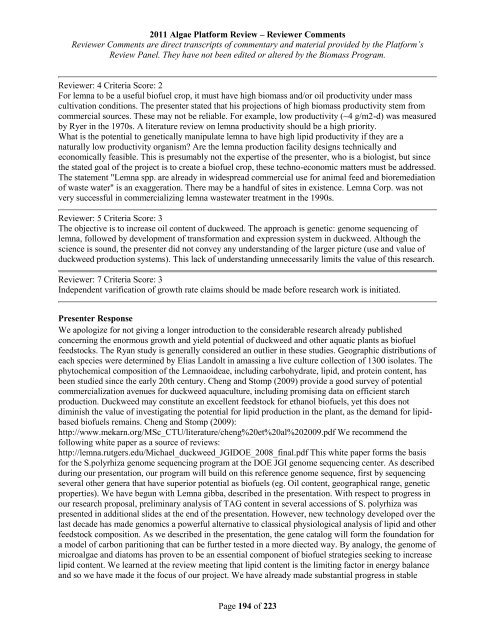Reviewer Comments - EERE
Reviewer Comments - EERE
Reviewer Comments - EERE
Create successful ePaper yourself
Turn your PDF publications into a flip-book with our unique Google optimized e-Paper software.
2011 Algae Platform Review – <strong>Reviewer</strong> <strong>Comments</strong><br />
<strong>Reviewer</strong> <strong>Comments</strong> are direct transcripts of commentary and material provided by the Platform’s<br />
Review Panel. They have not been edited or altered by the Biomass Program.<br />
<strong>Reviewer</strong>: 4 Criteria Score: 2<br />
For lemna to be a useful biofuel crop, it must have high biomass and/or oil productivity under mass<br />
cultivation conditions. The presenter stated that his projections of high biomass productivity stem from<br />
commercial sources. These may not be reliable. For example, low productivity (~4 g/m2-d) was measured<br />
by Ryer in the 1970s. A literature review on lemna productivity should be a high priority.<br />
What is the potential to genetically manipulate lemna to have high lipid productivity if they are a<br />
naturally low productivity organism? Are the lemna production facility designs technically and<br />
economically feasible. This is presumably not the expertise of the presenter, who is a biologist, but since<br />
the stated goal of the project is to create a biofuel crop, these techno-economic matters must be addressed.<br />
The statement "Lemna spp. are already in widespread commercial use for animal feed and bioremediation<br />
of waste water" is an exaggeration. There may be a handful of sites in existence. Lemna Corp. was not<br />
very successful in commercializing lemna wastewater treatment in the 1990s.<br />
<strong>Reviewer</strong>: 5 Criteria Score: 3<br />
The objective is to increase oil content of duckweed. The approach is genetic: genome sequencing of<br />
lemna, followed by development of transformation and expression system in duckweed. Although the<br />
science is sound, the presenter did not convey any understanding of the larger picture (use and value of<br />
duckweed production systems). This lack of understanding unnecessarily limits the value of this research.<br />
<strong>Reviewer</strong>: 7 Criteria Score: 3<br />
Independent varification of growth rate claims should be made before research work is initiated.<br />
Presenter Response<br />
We apologize for not giving a longer introduction to the considerable research already published<br />
concerning the enormous growth and yield potential of duckweed and other aquatic plants as biofuel<br />
feedstocks. The Ryan study is generally considered an outlier in these studies. Geographic distributions of<br />
each species were determined by Elias Landolt in amassing a live culture collection of 1300 isolates. The<br />
phytochemical composition of the Lemnaoideae, including carbohydrate, lipid, and protein content, has<br />
been studied since the early 20th century. Cheng and Stomp (2009) provide a good survey of potential<br />
commercialization avenues for duckweed aquaculture, including promising data on efficient starch<br />
production. Duckweed may constitute an excellent feedstock for ethanol biofuels, yet this does not<br />
diminish the value of investigating the potential for lipid production in the plant, as the demand for lipidbased<br />
biofuels remains. Cheng and Stomp (2009):<br />
http://www.mekarn.org/MSc_CTU/literature/cheng%20et%20al%202009.pdf We recommend the<br />
following white paper as a source of reviews:<br />
http://lemna.rutgers.edu/Michael_duckweed_JGIDOE_2008_final.pdf This white paper forms the basis<br />
for the S.polyrhiza genome sequencing program at the DOE JGI genome sequencing center. As described<br />
during our presentation, our program will build on this reference genome sequence, first by sequencing<br />
several other genera that have superior potential as biofuels (eg. Oil content, geographical range, genetic<br />
properties). We have begun with Lemna gibba, described in the presentation. With respect to progress in<br />
our research proposal, preliminary analysis of TAG content in several accessions of S. polyrhiza was<br />
presented in additional slides at the end of the presentation. However, new technology developed over the<br />
last decade has made genomics a powerful alternative to classical physiological analysis of lipid and other<br />
feedstock composition. As we described in the presentation, the gene catalog will form the foundation for<br />
a model of carbon paritioning that can be further tested in a more diected way. By analogy, the genome of<br />
microalgae and diatoms has proven to be an essential component of biofuel strategies seeking to increase<br />
lipid content. We learned at the review meeting that lipid content is the limiting factor in energy balance<br />
and so we have made it the focus of our project. We have already made substantial progress in stable<br />
Page 194 of 223




